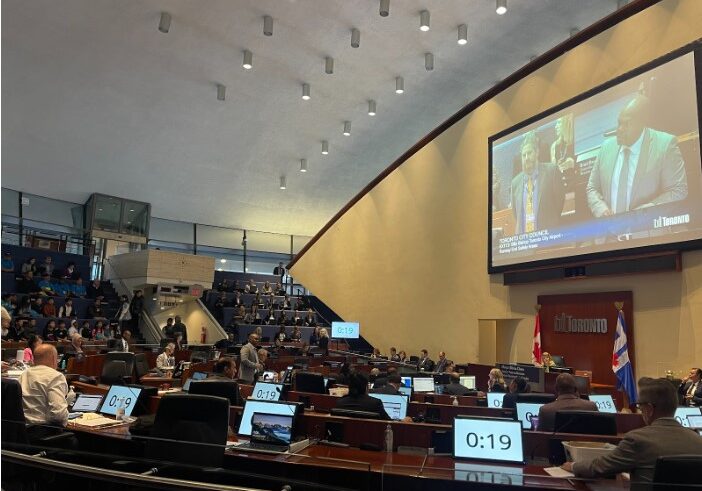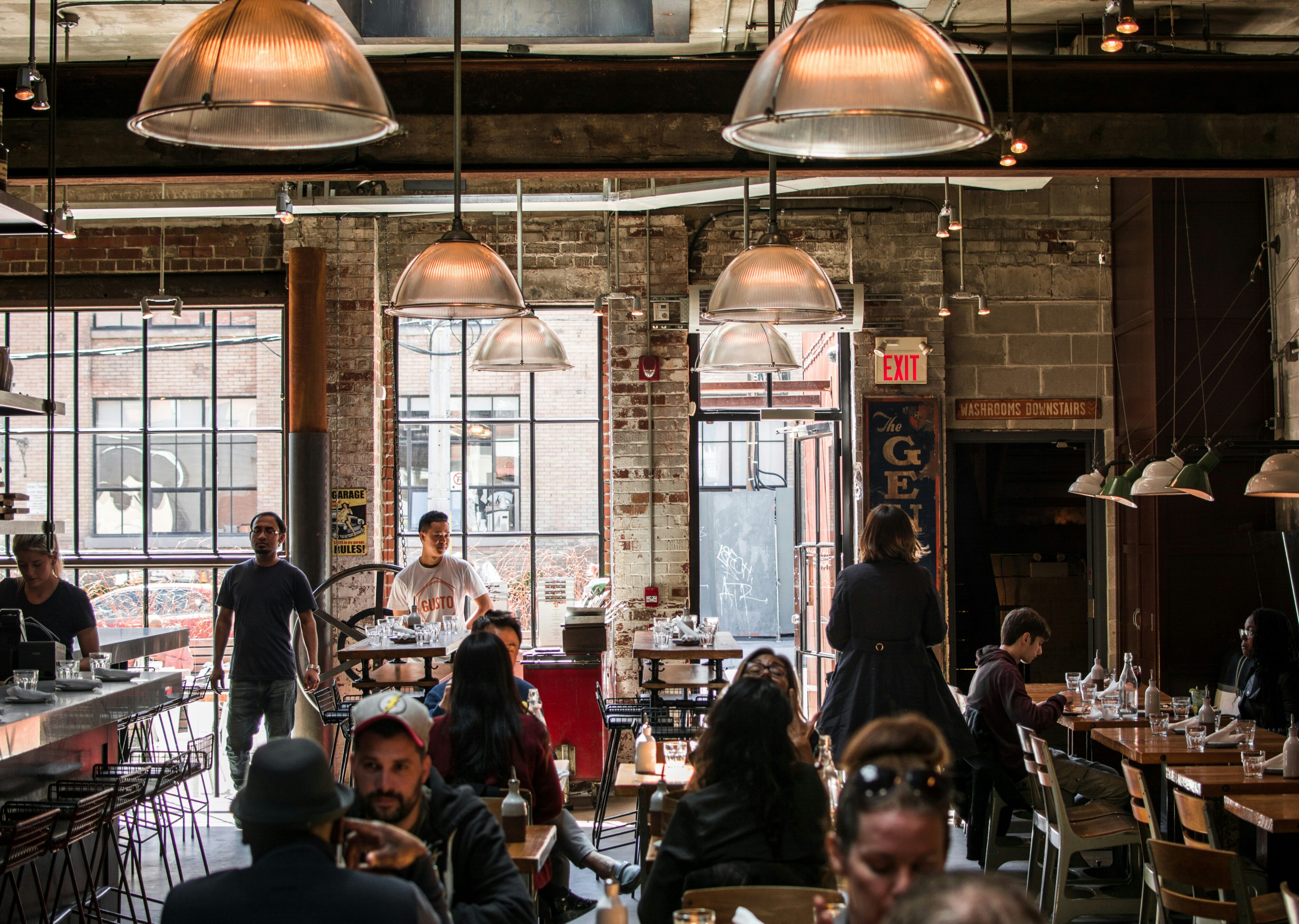City Council debates future of Billy Bishop. Will we still have an airport downtown?
THE GREEN LINE
DOCUMENTERS NOTES
City Council debates future of Billy Bishop. Will we still have an aiport downtown?
Tensions rose as councillors debated the environmental, financial and community impacts of the airport’s future.

THE TORONTO CITY COUNCIL MEETING ON OCT. 9, 2024.


TAYLOR SIMSOVIC
University of Toronto graduate and community worker living in Little Italy with four rescue pets. Passionate about tackling food insecurity and engaging communities.
October 10, 2024
These city meeting notes are part of Documenters Canada. Learn more about our program here.
City Council navigated tense debates over the future of Billy Bishop Airport on Oct. 9, ultimately backing a plan to meet federal safety standards while leaving broader questions about the airport's long-term future unresolved.
Around 20 to 30 people wore heart-shaped blue t-shirts that said, “It's my airport” and “YTZ.” They were scattered throughout the gallery, and filled the central section of the auditorium. Different groups of people came and left, including around seven Porter Airlines pilots and 30 firefighters at the start of the meeting, as they commemorated the 150th year of Toronto Fire Services operations. About 30 to 40 fifth grade students also attended as part of a field trip and were introduced by the mayor.
The atmosphere was that of anticipation from those in support of the Billy Bishop Airport. It took an hour and a half until 11 a.m. to get through most of the formalities as city councillors debated whether or not their questioning of officials in relation to the Billy Bishop Airport should be an in camera session or not.
There were debates and tensions between the mayor and city council, as well as between council members and officials who had created the consultation report. The importance of this agenda item was highlighted by the length of time spent discussing this topic.
The following officials were in attendance:
- Frances Nunziata, Councillor, York South-Weston – Speaker
- Paula Fletcher, Councillor, Toronto-Danforth – Deputy Speaker
- Mayor Olivia Chow
- Paul Ainslie, Councillor, Scarborough-Guildwood
- Brad Bradford, Councillor, Beaches-East York
- Alejandra Bravo, Councillor, Davenport
- Jon Burnside, Councillor, Don Valley East
- Shelley Carroll, Councillor, Don Valley North
- Lily Cheng, Councillor, Willowdale
- Mike Colle, Councillor, Eglinton-Lawrence
- Vincent Crisanti, Councillor, Etobicoke North
- Stephen Holyday, Councillor, Etobicoke Centre
- Parthi Kandavel, Councillor, Scarborough Southwest
- Ausma Malik, Councillor, Spadina-Fort York
- Nick Mantas, Councillor, Scarborough-Agincourt
- Josh Matlow, Councillor, Toronto-St. Paul’s
- Jennifer McKelvie, Councillor, Scarborough-Rouge Park
- Chris Moise, Councillor, Toronto Centre
- Amber Morley, Councillor, Etobicoke-Lakeshore
- Jamaal Myers, Councillor, Scarborough North
- James Pasternak, Councillor, York Centre
- Gord Perks, Councillor, Parkdale-High Park
- Anthony Perruzza, Councillor, Humber River-Black Creek
- Dianne Saxe, Councillor, University-Rosedale
- Michael Thompson, Councillor, Scarborough Centre
THE BIG QUESTION
What did members of the community have to say?
A presentation was delivered by David Stonehouse, the city’s waterfront secretariat.
- “This report/decision is not about closing the Billy Bishop Toronto City Airport,” he said.
- The goal is to reduce severity of damage to the aircraft if it overshoots or overruns the runway.
- RESA compliance is the responsibility of airports, but approval from the city is required. YTZ is operated by Tripartite Agreement between PortsToronto, City of Toronto and Transport Canada.
- Compliance by lengthening the runway requires infill into the lake, which needs city council approval.
PortsToronto is conducting an environmental assessment, which is evaluating three options for implementation to adhere with guidelines:
- Option 1: Meet minimum landmass (by building additional runway space in the airport) to meet regulatory requirements. Cost estimate is $61-64 million.
- Staff found that this is the most efficient and recommended option for compliance.
- Option 2: Have minimum landmass and additional taxiway. Cost estimate is $93-97 million
- Option 3: Have minimum landmass, taxiway, additional airside roads, sound barrier and underground corridor. Cost estimate is $169-175 million.
There was mainly a discussion about the cost, environmental impact and the special connection of the airport to the queer history of Hanlan’s point, a gathering point for the queer community since the early 20th century. There was also a broader discussion about the airport’s lease and whether or not to renew it in the long-term.
Deputy Mayor McKelvie asked the staffer from PortsTO about whether or not there are technical reasons to object to the other features of options 2 and 3 (i.e. objections to soundproofing).
Coun. Moise asked PortsTO about the noise of the planes, and why it wasn’t factored into all three options. Stonehouse responded that this is still a large outstanding question and is best addressed through the airport master-planning process, so potential solutions can be reviewed with a larger group.
Coun. Pasternak said there are not enough diverging opinions within the report. PortsTO staffer responded that the team reported and recorded what they heard from the community.
Coun. Morley asked about safety considerations regarding school buses that use the same area during the winter and about considering varying public opinions. She asked about funding for this project and about examples of successful financing pathways.
Many city councillors were asking where the finances are going to come from, and the timeline for amortization.
Coun. Bradford asked more about funding and how that will be paid back within the terms of the lease. He also asked about the presentation that Stonehouse showed, which said this proposal is not really about the future of the airport; but then he added that without the runway and lease extension, the future of Billy Bishop is at risk.
Coun. Bravo asked Stephen Conforti, CFO and treasurer of the City of Toronto, about regaining investments in the project through revenues. Conforti said this is a possibility.
- Bravo asked city manager Paul Johnson about the impacts of a potential high-speed rail corridor and how shifting modalities might have an impact on the airport. Johnson said this was just about the safety requirements and not about these other issues.
Coun. Saxe asked Johnson about whether or not the recommended proposal meant that Billy Bishop would continue to occupy that area past 2033. She also asked about lead toxins from the fumes of planes and the environmental and health impacts of this exposure.
- Johnson said the environmental concerns are a major consideration within their proposals.
After the recess, Mayor Chow said the city is not closing the runway, and has to bring it into compliance with RESA. Option 1 is the safest, lowest-risk, cheapest, quickest and does not destroy Hanlan’s point. Other options would take more time, massive landfilling of Lake Ontario and more complex construction. This all needs to start next summer in order for them to meet the deadline.
- Motion is to lead with Option 1. Extending the lease for Billy Bishop to get the financing necessary to complete these upgrades is something that the city would support.
- Still need to decide the future of the airport, especially since there are going to be 100,000 more residents in close proximity with Villiers Island and the other portlands.
Chow was asked by Coun. Holyday for her long-term view for Billy Bishop.
- Chow said it is developing rapidly, and pointed out that it is an important question for experts to consider.
- Holyday questioned if that means she thinks flights should continue into the future.
- Chow responded that the airport should stay where it is. Holyday said the city should make investments now, and that it should do better than option 1 since the other options are more comprehensive.
Coun. Mantas asked about the probability of these runway problems occuring, and why option 1 was determined to be the best fit. Chow responded that it was not up to her, and that Transport Canada decided to make these policy changes.
- Chow said the residents did not say they needed new roads or a sandwall. They were pushing for option 1.
- Mantas asked if they could conduct a citywide poll. Chow said that could be conducted when they are talking about the future of the entire airport, but this is really just a consideration of the RESA.
McKelvie said this is a federally regulated project and that council should “cede to that advice” from the feds.
- Coun. Colle questioned if options two and three would meet the regulations, or to go beyond them.
- McKelvie responded that, yes, these are additional measures (i.e. safety, sound, etc.) that PortsTO has identified. They have not been required by the federal government. Colle said McKelvie was “dragging the puck” (i.e. not letting him speak) and they had some back-and-forth.
Councillor Colle highlighted the locality of the airport and said, “It is a quirky airport; it is a unique airport — by no means is it perfect like Pearson airport is but it's our airport,” to laughs from the chamber. “You can actually see people walk to go to their airport.”
Bradford said Chow signing the existing tripartite agreement would lock the airport into using an outdated model of a plane that is no longer being manufactured.
Coun. Fletcher said, “I’ve not seen a lobbying effort like this for a long time.” She accused the other councillors of having been lobbied and told them to grow up.
- “You want a megamall, you want a ferris wheel, a minirail? Do you want that? That was the last time we did this on the waterfront, and we had to stop it. It's the central waterfront; it's a very delicate place.” She pointed to the mass housing developments on the waterfront, access to the Toronto Islands and new ferries as being reasons why it is important to really consider what is going on at the airport location during this decision-making process.
- She advocated for option 1, and pointed to decades-long and city-wide efforts to develop the waterfront to meet everyone's needs.
Coun. Perks rebutted Bradford’s previous comments on the terms of the lease being outdated since they are from 40 years ago. He said it doesn't make sense to criticize the fact that people in the 1980s didn't have the foresight to know all the intricacies of what would be needed at the site today by then proposing another 40-year lease.
Deputy Mayor Malik advocated for all stakeholders to be engaged in the long-term planning process, while making sure that the federal safety requirements are met in an efficient manner.
What was the outcome of this motion?
The motion was carried with votes 17 to 8.
- Yes: 17 – Paul Ainslie, Alejandra Bravo, Shelley Carroll, Lily Cheng, Olivia Chow, Mike Colle, Paula Fletcher, Ausma Malik, Josh Matlow, Chris Moise, Amber Morley, Jamaal Myers, Frances Nunziata (Chair), Gord Perks, Anthony Perruzza, Dianne Saxe, Michael Thompson
- No: 8 – Brad Bradford, Jon Burnside, Vincent Crisanti, Stephen Holyday, Parthi Kandavel, Nick Mantas, Jennifer McKelvie, James Pasternak
This means “City Council [states] its commitment to a long-term lease extension and the renegotiation of the Tripartite Agreement to ensure ongoing and future operations of the Billy Bishop Toronto City Airport, and direct the City Manager to represent Council’s position in discussions with PortsToronto and Transport Canada following the successful completion of Runway End Safety Area (RESA) obligations.”
Fact-Check Yourself
Sources and
further reading
Don't take our word for it —
check our sources for yourself.
Care about our city, but don't know how to make it better? Sign up for simple, step-by-step guides to solving problems in your neighbourhood — one small action at a time.
